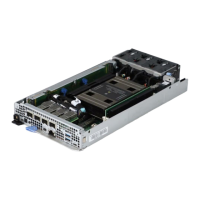System security
In the BIOS, access System Security to view details.
Steps
1. To view the System Security screen, power on the system and press F2.
2. Click System Setup Main Menu, System BIOS, and then System Security.
Table 25. System Security details
Option Description
CPU AES-NI Improves the speed of applications by performing encryption and decryption by using
the Advanced Encryption Standard Instruction Set (AES-NI). The default value is
Enabled.
System Password Sets the system password. The default value is Enabled and is read-only if the
password jumper is not installed in the system.
Setup Password Sets the setup password. This option is read-only if the password jumper is not
installed in the system.
Password Status Locks the system password. The default value is Unlocked.
TPM Information Indicates the type of Trusted Platform Module, if present.
Table 26. TPM 2.0 security information
Option Description
TPM Information
TPM Security
NOTE: The TPM menu is available only when the TPM module is installed.
Enables you to control the reporting mode of the TPM. When set to Off, the presence
of the TPM is not reported to the operating system. When set to On, the presence of
the TPM is reported to the operating system. The default value for TPM Security is
Off.
When TPM 2.0 is installed, the TPM Security option is set to On or Off. The default
value is Off.
TPM Information Indicates the type of Trusted Platform Module, if present.
TPM Firmware Indicates the firmware version of the TPM.
TPM Hierarcy Enables, disables, or clears the storage and endorsement hierarchies. When set to
Enabled, the storage and endorsement hierarchies can be used.
When set to Disabled, the storage and endorsement hierarchies cannot be used.
When set to Clear, the storage and endorsement hierarchies are cleared of any
values, and then reset to Enabled.
TPM Advanced Settings Specifies TPM Advanced Settings details.
Table 27. System Security details
Option Description
Intel(R) TXT Enables you to set the Intel Trusted Execution Technology (TXT) option. Enabling the
Intel TXT option requires that virtualization technology and TPM Security are enabled
with Preboot measurements. The default value is Off. It is set On for Secure Launch
(Firmware Protection) support on Windows 2022.
Memory Encryption Enables or disables the Intel Total Memory Encryption (TME) and MultiTenant
(Intel
®
TME-MT). When option is set to Disabled, BIOS disables both TME and
MK-TME technology. When this option is set to Single Key, the BIOS enables the
Pre-operating system management applications 37

